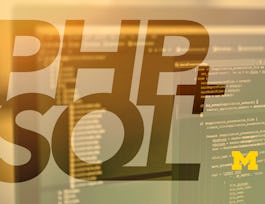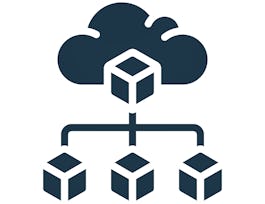Node is the first choice for developing server-side applications as it allows for cross-platform application development. When connected with databases, Node revolutionizes the development of web applications, enabling robust and scalable data manipulation.



Node.js & MongoDB: Developing Back-end Database Applications
This course is part of multiple programs.


Instructors: Ramanujam Srinivasan
Sponsored by Syrian Youth Assembly
5,329 already enrolled
(28 reviews)
Recommended experience
What you'll learn
Implement fundamental back-end development concepts with Node, Express, and NoSQL databases
Develop secure RESTful APIs using Node and Express to communicate with databases
Apply authentication and authorization mechanisms and implement error handling
Scale and deploy Node database applications on a cloud platform
Details to know

Add to your LinkedIn profile
10 assignments
See how employees at top companies are mastering in-demand skills

Build your subject-matter expertise
- Learn new concepts from industry experts
- Gain a foundational understanding of a subject or tool
- Develop job-relevant skills with hands-on projects
- Earn a shareable career certificate


Earn a career certificate
Add this credential to your LinkedIn profile, resume, or CV
Share it on social media and in your performance review

There are 6 modules in this course
This module introduces you to data and databases. You will learn about relational and non-relational NoSQL databases and their uses. You will also be introduced to MongoDB, and its capabilities, and understand how to leverage it for your database needs. Finally, you will also design and implement a database for a product catalog.
What's included
8 videos2 readings2 assignments1 app item3 plugins
In this module, you will learn about NoSQL databases. You will explore how to create scalable and efficient Node applications using the NoSQL database, MongoDB. You will also learn how to choose a NoSQL database for your Node application. You get oriented with the process of connecting Node to the MongoDB database and explore how to troubleshoot these connections. This module will also help you familiarize with the features of MongoDB and enable you to query and manipulate data using it. You will understand CRUD operations. You will learn different techniques of authentication, authorization, and handling user sessions and cookies.
What's included
7 videos1 reading2 assignments3 app items1 plugin
In this module, you will learn APIs and RESTful APIs. You will explore HTTP methods in RESTful APIs, resource and endpoint design, different data formats, how to authenticate clients and grant access to protected resources. This module provides you with insights into the Express framework, routes and controllers. You will study how to handle errors in request processing. This module is a guide to various approaches to versioning during API. You will delve into the common pagination techniques including how to manage conflicts between versioning and pagination. This module orients you with CRUD operations and how to implement them. You will get an understanding of JSON web tokens, also known as JWT, which are used to secure applications with RESTful API.
What's included
6 videos1 reading2 assignments3 app items
This module introduces you to error handling in Node. You will learn common types of errors and explore various error-handling techniques. This module provides you with an overview of customer error-handling middleware, its benefits, and its implementation in real-world scenarios. You will also get familiar with request validation and request sanitization using common request validation techniques. This module also introduces you to rate limiting and throttling.
What's included
6 videos1 reading2 assignments3 app items
In this module you will explore the Node application deployment process, manage dependencies and versions and familiarize yourself with authentication and authorization mechanisms. This module presents you with the process of increasing the capacity of an application via an overview of different scaling approaches and load-balancing strategies. You will understand how to design scalable node architecture, get introduced to load balancing and high availability, and how to implement fault recovery mechanisms.
What's included
5 videos1 reading2 assignments3 app items1 plugin
In this module you will complete a final project based on the concepts of developing a web application for a Social Media Dashboard with user authentication, security based on JSON Web Tokens (JWT), and post management. The back-end is implemented using Node.js and Express, while the frontend utilizes HTML, CSS, and JavaScript. Key features include user registration, login, post creation, and pagination. The design emphasizes simplicity and security through middleware and session management.
What's included
2 readings1 peer review2 app items1 plugin
Instructors


Offered by
Why people choose Coursera for their career




Learner reviews
28 reviews
- 5 stars
66.66%
- 4 stars
20%
- 3 stars
10%
- 2 stars
3.33%
- 1 star
0%
Showing 3 of 28
Reviewed on Mar 12, 2024
best course. It includes real world best practices and also it teaches how to tackle common web vulnerabilities
Recommended if you're interested in Computer Science
 Status: [object Object]
Status: [object Object]
University of Michigan

Open new doors with Coursera Plus
Unlimited access to 10,000+ world-class courses, hands-on projects, and job-ready certificate programs - all included in your subscription
Advance your career with an online degree
Earn a degree from world-class universities - 100% online
Join over 3,400 global companies that choose Coursera for Business
Upskill your employees to excel in the digital economy




